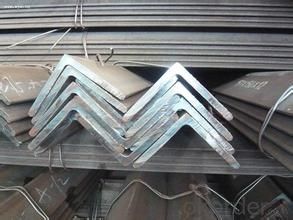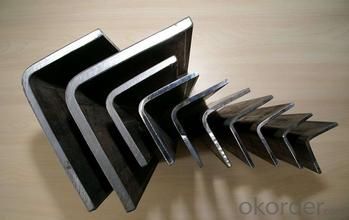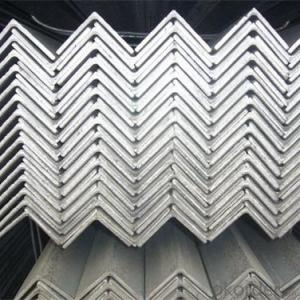Hot Rolled Equilateral Small Angle Steel
- Loading Port:
- Tianjin
- Payment Terms:
- TT or LC
- Min Order Qty:
- 25 m.t.
- Supply Capability:
- 2000 m.t./month
OKorder Service Pledge
OKorder Financial Service
You Might Also Like
Product Description:
OKorder is offering Hot Rolled Equilateral Small Angle Steel at great prices with worldwide shipping. Our supplier is a world-class manufacturer of steel, with our products utilized the world over. OKorder annually supplies products to European, North American and Asian markets. We provide quotations within 24 hours of receiving an inquiry and guarantee competitive prices.
Product Applications:
Hot Rolled Equilateral Small Angle Steel are ideal for structural applications and are widely used in the construction of buildings and bridges, and the manufacturing, petrochemical, and transportation industries.
Product Advantages:
OKorder's Hot Rolled Equilateral Small Angle Steel are durable, strong, and resist corrosion.
Main Product Features:
· Premium quality
· Prompt delivery & seaworthy packing (30 days after receiving deposit)
· Corrosion resistance
· Can be recycled and reused
· Mill test certification
· Professional Service
· Competitive pricing
Product Specifications:
Manufacture: Hot rolled
Grade: Q195 – 235
Certificates: ISO, SGS, BV, CIQ
Length: 6m – 12m, as per customer request
Packaging: Export packing, nude packing, bundled
Chinese Standard (H*W*T) | Weight (Kg/m) | 6m (pcs/ton) | Light I (H*W*T) | Weight (Kg/m) | 6m (pcs/ton) | Light II (H*W*T) | Weight (Kg/m) | 6M |
100*68*4.5 | 11.261 | 14.8 | 100*66*4.3 | 10.13 | 16.4 | 100*64*4 | 8.45 | 19.7 |
120*74*5.0 | 13.987 | 11.9 | 120*72*4.8 | 12.59 | 13.2 | 120*70*4.5 | 10.49 | 15.8 |
140*80*5.5 | 16.89 | 9.8 | 140*78*5.3 | 15.2 | 10.9 | 140*76*5 | 12.67 | 13.1 |
160*88*6 | 20.513 | 8.1 | 160*86*5.8 | 18.46 | 9 | 160*84*5.5 | 15.38 | 10.8 |
180*94*6.5 | 24.143 | 6.9 | 180*92*6.3 | 21.73 | 7.6 | 180*90*6 | 18.11 | 9.2 |
200*100*7 | 27.929 | 5.9 | 200*98*6.8 | 25.14 | 6.6 | 200*96*6.5 | 20.95 | 7.9 |
220*110*7.5 | 33.07 | 5 | 220*108*7.3 | 29.76 | 5.6 | 220*106*7 | 24.8 | 6.7 |
250*116*8 | 38.105 | 4.3 | 250*114*7.8 | 34.29 | 4.8 | 250*112*7.5 | 28.58 | 5.8 |
280*122*8.5 | 43.492 | 3.8 | 280*120*8.2 | 39.14 | 4.2 | 280*120*8 | 36.97 | 4.5 |
300*126*9 | 48.084 | 3.4 | 300*124*9.2 | 43.28 | 3.8 | 300*124*8.5 | 40.87 | 4 |
320*130*9.5 | 52.717 | 3.1 | 320*127*9.2 | 48.5 | 3.4 | |||
360*136*10 | 60.037 | 2.7 | 360*132*9.5 | 55.23 | 3 |
FAQ:
Q1: Why buy Materials & Equipment from OKorder.com?
A1: All products offered byOKorder.com are carefully selected from China's most reliable manufacturing enterprises. Through its ISO certifications, OKorder.com adheres to the highest standards and a commitment to supply chain safety and customer satisfaction.
Q2: How do we guarantee the quality of our products?
A2: We have established an advanced quality management system which conducts strict quality tests at every step, from raw materials to the final product. At the same time, we provide extensive follow-up service assurances as required.
Q3: How soon can we receive the product after purchase?
A3: Within three days of placing an order, we will begin production. The specific shipping date is dependent upon international and government factors, but is typically 7 to 10 workdays.
Q4: What makes stainless steel stainless?
A4: Stainless steel must contain at least 10.5 % chromium. It is this element that reacts with the oxygen in the air to form a complex chrome-oxide surface layer that is invisible but strong enough to prevent further oxygen from "staining" (rusting) the surface. Higher levels of chromium and the addition of other alloying elements such as nickel and molybdenum enhance this surface layer and improve the corrosion resistance of the stainless material.
Q5: Can stainless steel rust?
A5: Stainless does not "rust" as you think of regular steel rusting with a red oxide on the surface that flakes off. If you see red rust it is probably due to some iron particles that have contaminated the surface of the stainless steel and it is these iron particles that are rusting. Look at the source of the rusting and see if you can remove it from the surface.
Images:



- Q:How do you install steel angles?
- In order to install steel angles, there are several steps that need to be followed. Begin by determining the suitable location and angle for the steel angle. Use a tape measure and a level to ensure proper alignment. Proceed by marking the spots where the steel angle will be installed. Precise markings can be made on the wall or floor using a pencil or chalk. Once the markings are finished, create pilot holes at the marked locations using a drill. The drill bit size should match the size of the screws or anchors you plan to use. It is important to drill into the studs or solid support structure behind the wall to ensure a secure installation. After drilling the pilot holes, align the steel angle with the markings on the wall or floor. Make use of a level to guarantee it is perfectly straight. Once aligned, insert screws or anchors through the holes in the steel angle and into the pilot holes. Using a screwdriver or drill, tighten the screws or anchors until the steel angle is firmly attached to the wall or floor. Repeat this process for any additional steel angles that need to be installed. Finally, check the installation to verify that the steel angles are level and securely attached. If necessary, make any adjustments to the screws or anchors to achieve proper installation. Always remember to follow the instructions provided by the manufacturer and take appropriate safety precautions when installing steel angles. If you are uncertain about any step of the installation process, it is advisable to seek professional assistance.
- Q:What is the maximum length of a continuous steel angle?
- The maximum length of a continuous steel angle typically depends on various factors such as the manufacturing process, transportation limitations, and structural requirements. However, in general, the maximum length of a continuous steel angle can range anywhere from a few meters to several tens of meters.
- Q:How do you store steel angles?
- Steel angles can be stored in a variety of ways depending on the available space and the quantity of angles. Here are a few common methods: 1. Vertically: One option is to store steel angles vertically by leaning them against a wall or using a storage rack. This method is suitable for smaller quantities as it allows easy access to each angle. It is important to ensure that the angles are stable and securely positioned to prevent any accidents. 2. Horizontally: Another option is to store steel angles horizontally, especially if you have a larger quantity. This can be done by stacking them on a pallet or using a storage rack with compartments. When stacking, it is crucial to distribute the weight evenly and use spacers between the angles to avoid deformation. 3. Bundled: If you have a large number of steel angles, bundling them together can be a convenient storage method. This is achieved by tying the angles together with steel strapping or using banding equipment. Bundling helps to keep the angles organized and prevents them from shifting or falling during storage or transportation. Regardless of the storage method chosen, it is important to consider the following points: - Provide a clean and dry storage area to prevent rust or corrosion. - Ensure the storage area is well-ventilated to avoid moisture buildup. - Keep the angles away from direct sunlight and extreme temperature fluctuations. - Regularly inspect the angles for any signs of damage or corrosion. - Use appropriate lifting equipment and follow safety guidelines when moving or stacking steel angles.
- Q:How do steel angles differ from steel channels?
- Steel angles and steel channels are both structural steel shapes that are commonly used in construction and engineering applications. However, they differ in terms of their shape and structural properties. Firstly, steel angles have an L-shaped cross-section, with two legs that are perpendicular to each other. The legs can have equal or unequal lengths, depending on the specific application. This L-shaped design provides greater stability and strength, making steel angles ideal for applications that require load-bearing capabilities, such as supporting beams or columns. They are often used in the construction of frames, braces, and for reinforcing structures. On the other hand, steel channels have a U-shaped cross-section, with a flat bottom and two parallel legs that are connected by a vertical web. The legs of steel channels are usually tapered or have rounded edges. The U-shaped design allows steel channels to provide excellent resistance to bending and torsion, making them suitable for applications that require structural support and stability, such as the construction of framing systems, support beams, and building facades. Another key difference between steel angles and steel channels is their weight-bearing capacity. Steel angles, due to their L-shaped design and shorter legs, are generally more efficient in carrying vertical loads. Conversely, steel channels, with their wider and more extensive cross-section, are better suited to bear horizontal loads. In terms of installation, steel angles are typically bolted or welded to other steel members, providing a strong connection. Steel channels, on the other hand, can be connected by welding, bolting, or even by using clips or brackets, depending on the specific application and load requirements. In summary, steel angles and steel channels differ in terms of their cross-sectional shape, load-bearing capacity, and structural properties. Steel angles are L-shaped and are more suited for vertical load-bearing applications, while steel channels are U-shaped and are better suited for horizontal load-bearing applications. Both shapes have their respective advantages and are commonly used in various construction and engineering projects.
- Q:How are steel angles cut to specific lengths?
- Steel angles can be cut to specific lengths using various tools and methods such as sawing, shearing, or using a plasma cutting machine. These techniques allow for precise and accurate cuts based on the required measurements.
- Q:What is the typical thickness of the base of a steel angle?
- The base thickness of a steel angle can vary depending on its specific application and requirements. Typically, the base thickness of a steel angle ranges from 1/8 inch to 3/8 inch. It is worth mentioning that this range is not comprehensive, and there may be instances where the base thickness deviates from these parameters. Elements such as the steel angle's size, load-bearing capacity, and intended purpose will impact the necessary base thickness for a particular project or structure. As a result, consulting engineering specifications or seeking professional guidance is crucial in determining the suitable base thickness for a steel angle in a specific application.
- Q:What are the different types of steel angle connections used in seismic design?
- In seismic design, there are several types of steel angle connections commonly used. These connections are specifically designed to withstand the forces and movements experienced during seismic events. Some of the different types of steel angle connections used in seismic design include: 1. Bolted Flange Plate Connection: This type of connection involves bolting a steel plate to the flanges of two angle sections. It provides good resistance against lateral and vertical forces and can accommodate rotational movements. 2. Welded Flange Plate Connection: Similar to the bolted flange plate connection, this connection involves welding a steel plate to the flanges of two angle sections. It offers high strength and stiffness, but it is less ductile compared to the bolted version. 3. Extended Single Plate Connection: This connection is created by extending a single plate beyond the flanges of two angle sections and then welding it to both the flanges. It provides good resistance against lateral and vertical forces and can accommodate some degree of rotation. 4. Double Angle Connection: In this connection, two angle sections are connected together using bolts or welds. It offers high strength and stiffness and can resist lateral and vertical forces effectively. 5. Diagonal Brace Connection: This type of connection involves connecting diagonal braces to the flanges of two angle sections. It provides enhanced resistance against lateral forces and can effectively control building sway during seismic events. 6. Gusset Plate Connection: This connection involves using a gusset plate to connect two or more angle sections together. It provides good strength and stiffness and can resist lateral and vertical forces effectively. Each of these steel angle connections has its own advantages and disadvantages, and the choice of which connection to use depends on factors such as the structural design requirements, loadings, and the level of seismic activity in the region. It is important to carefully consider these factors and consult with structural engineers to ensure the appropriate connection type is used for a seismic design project.
- Q:Are steel angles suitable for supporting heavy machinery?
- Yes, steel angles are suitable for supporting heavy machinery. Steel angles are known for their strength and durability, making them a reliable choice for providing structural support to heavy machinery. They offer excellent load-bearing capabilities and can withstand the weight and stress exerted by heavy machinery, ensuring stability and safety.
- Q:How do you connect steel angles together?
- There are several ways to connect steel angles together depending on the specific application and load requirements. Here are a few common methods: 1. Welding: The most common and effective method is to weld the steel angles together. This creates a strong and permanent connection. It is important to ensure proper welding techniques are followed to maintain the integrity and strength of the joint. 2. Bolting: Another method is to use bolts and nuts to connect the steel angles. This allows for easy disassembly and reassembly if required. It is important to use the correct size and grade of bolts to ensure the connection can withstand the intended loads. 3. Riveting: Rivets can also be used to connect steel angles together. This method provides a strong and permanent connection, but it requires specialized tools and expertise to properly install the rivets. 4. Adhesive bonding: In some cases, adhesive bonding techniques can be used to connect steel angles together. This method is usually used in conjunction with other fastening methods, such as welding or bolting, to provide additional strength and stability. When choosing the method to connect steel angles, it is important to consider factors such as the load requirements, environmental conditions, and expected lifespan of the structure. Consulting with a structural engineer or a professional in the field is recommended to ensure the best connection method is chosen for your specific application.
- Q:Are there any environmental concerns associated with steel angles?
- Steel angles are associated with various environmental concerns. The production process involves extracting iron ore, mining coal for coke production, and emitting greenhouse gases during steelmaking. These activities contribute to deforestation, air pollution, and climate change. Furthermore, disposing of steel angles at the end of their life cycle can be problematic. Steel is not biodegradable and can take hundreds of years to decompose in landfills. Improper disposal can contaminate soil and water, posing risks to ecosystems and human health. Moreover, transporting steel angles from production facilities to construction sites can lead to carbon emissions and air pollution. The energy needed for transportation increases the overall environmental impact. To address these concerns, several strategies can be implemented. Firstly, using recycled steel instead of virgin steel significantly reduces the environmental footprint. Additionally, employing energy-efficient technologies in the production process can minimize greenhouse gas emissions. Lastly, responsibly disposing and recycling steel angles at the end of their life cycle helps reduce the environmental impact.
1. Manufacturer Overview |
|
|---|---|
| Location | |
| Year Established | |
| Annual Output Value | |
| Main Markets | |
| Company Certifications | |
2. Manufacturer Certificates |
|
|---|---|
| a) Certification Name | |
| Range | |
| Reference | |
| Validity Period | |
3. Manufacturer Capability |
|
|---|---|
| a)Trade Capacity | |
| Nearest Port | |
| Export Percentage | |
| No.of Employees in Trade Department | |
| Language Spoken: | |
| b)Factory Information | |
| Factory Size: | |
| No. of Production Lines | |
| Contract Manufacturing | |
| Product Price Range | |
Send your message to us
Hot Rolled Equilateral Small Angle Steel
- Loading Port:
- Tianjin
- Payment Terms:
- TT or LC
- Min Order Qty:
- 25 m.t.
- Supply Capability:
- 2000 m.t./month
OKorder Service Pledge
OKorder Financial Service
Similar products
New products
Hot products
Hot Searches
Related keywords



























